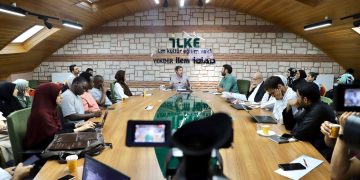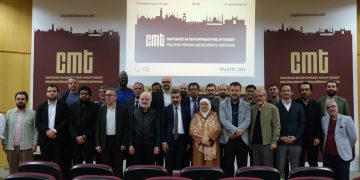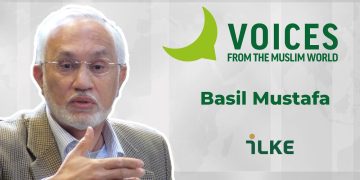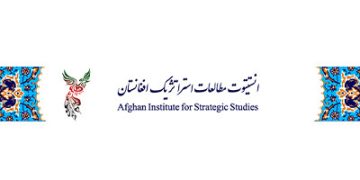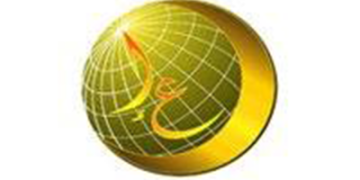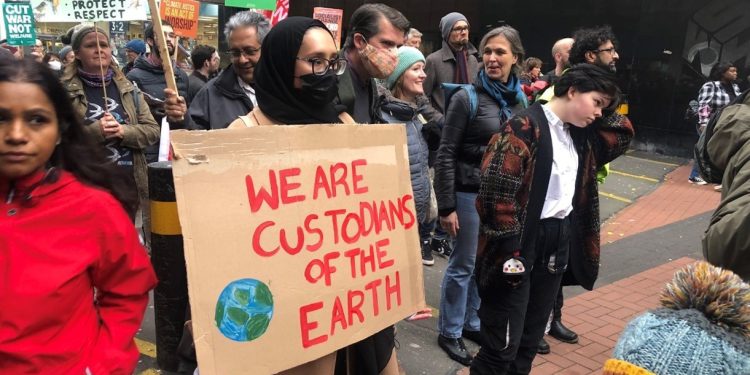The concept of “social movement”, which was first used by the German sociologist Lorenz Von Stein, is one of the social science topics that are widely researched today. Meeting people around a problem that they identify as a problem and taking some steps to solve this problem is one of the important processes that fuel social change. At the beginning of the 19th century, there were widespread opinions that when people came together, they formed a collective consciousness and acted decisively together to explain this change. The social analysis of Marxism, which is based on production relations and built on the basis of class, has also taken the study of movement to a different dimension. The social movements that previously were revolving around the discussions of class struggle and the workers’ revolutions underwent a structural break with the student uprisings in 1968. Social movements dominated by the search for rights based on identity rather than economic demands are being discussed together with areas such as democratization and civil society today. Habermas expounds this distinction in a terse way by saying that new conflicts arise not from the problems of division, but from the “grammatical problems of lifestyles” (Habermas, 2001, p. 849).
Since the second half of the 19th century, environmental problems have started to be discussed all over the world, especially with Rachel Carson’s famous book Silent Spring (1962). Many observable and measurable deteriorations such as global warming, extinction of some living species, depletion of the ozone layer, increase in the average temperature of the earth from year to year, plastic waste threatening life in the seas and oceans, and increasing air and particle pollution in cities has led researchers from various disciplines around the orld to reveal the dimensions, causes and consequences of pollution from their own perspectives. The approaches of different religions towards the environment and environmental problems have also been discussed for a long time. Lynn White’s article “Historical Roots of Our Ecological Crisis” (1967) was the first study in this field. Finding the root of environmental problems in the anthropocentric understanding of cosmology of Christianity, which shapes the Western culture, White’s article has shed light on all living religions, especially Christianity, to reveal their understanding of the environment. Since the 1970s, works that explore the perspectives of religions on the environment have begun to be published.
Islamic Environmentalism
Although Islam treats environmentalism as a subject of academic research yet the main motivation that turned it into a movement is that Muslims see the environmental understanding of Islam not as a knowledge learned by mere reading; they understand them as religious principles regarding environment that need to be put in practice. Therefore, what we mean by “Islamic environmentalism” in this article are environmental activities and attitudes that are based on the basic sources of Islam. Grounding Islamic environmentalism in this way requires drawing a line between the environmental movements in which Muslims actively participate and the Islamic environmental movements. As Hamed underlined, environmental movements that Muslims are a part of carry out their activities by being inspired by many other sources besides Islam (Hamed, 1993, p. 146). It can even be said that the environmental movements that emerged in the geographies where Muslims live as a majority continue to work in the same way, following the examples of Western-based secular models rather than Islamic references (Foltz, 2006, p. 208). However, Islamic environmentalism has a different basis from secular environmental movements. Today, it is active in different parts of the world as a movement that takes its inspiration and motivation from the teachings of the religion of Islam on environment, tries to establish an environmental understanding based on Islam, and performs all kinds of activities for this purpose. However, what makes a movement Islamic is not just that it is practiced by Muslims. The distinctive features of Islamic environmentalism are that it puts Islam on the basis of environmentalism, that it establishes its concepts and principles by being inspired by Islam, that its participants perform all kinds of environmental activities with devotion as if they are fulfilling a religious duty, and that being a Muslim and an environmentalist turns into a symbiotic relationship that supports each other.
There are some features that distinguish Islamic environmentalism from secular environmentalism. Islamic environmentalism is holistic and has two foundations, one idealistic and the other pragmatic. On an idealist basis, there is a fundamental bond and interdependence between all natural elements. Accordingly, the environment has a perfect order and should be protected in all aspects in order not to suffer any destructive damage. On the pragmatic basis, it carries the aim of establishing the public interest. Since the world’s natural resources are limited, they must be protected for all individuals, communities, species and future generations. In short, Islamic environmentalism was established as a social norm with a pragmatic purpose in order to prevent the emergence of environmental problems (Yıldırım, 2016, pp. 217-218).
Besides these theoretical discussions, Islamic environmentalism also has a practical dimension. Although there is no statistical study that reveals the percentage of Muslims who are interested in environmental problems in their country, there are studies that conclude that the environmental issue is a marginal concern among Muslims (Hancock, 2018, p. 64). It can be deduced from such studies that Muslims living as a minority in the West are trying to integrate into their respective countries despite the difference in their religious beliefs, by supporting the established environmental practices in their country and showing that environmentalism is also supported by Islam (Keskin, 2022, p. 267). The underlying reasons for a more distant approach of Muslim majority countries towards environmental issues, compared to the West, range from the low levels of economic development in the relevant countries to the limited functioning of their civil society.
It would be appropriate to group the associations that develop an environmental understanding inspired by Islam under two headings as countries where Muslims live as a minority and where Muslims are in majority. The most well-known associations in the first group of countries are Islamic Foundation for Ecology and Environmental Sciences (IFEES) (England), Green Muslims (USA), Groene Moslims (Netherlands), Wisdom in Nature (England), Green Initiative by ISNA / Islamic Society of North America (USA), and ShINE / Sheffield Islamic Network for the Environment (England). Although there are limtited examples of such organisations in in the second group, some prominent ones include the ÇEKUD (TCV) and Environment Foundation operating in Türkiye, and the Disaster Management and Climate Change Institute (LPBI-NU) established under the Nahdatul Ulama in Indonesia. In the rest of the article, a general framework is drawn about IFEES, as it has been active for a long time and was established before other similar associations.
IFEES (Islamic Foundation for Ecology and Environmental Sciences)
The organization was established in Birmingham in 1994 and has been working to make Muslims more conscious about environment and environmental problems by organizing various activities around the world. They stated their aim as to establish a conservation practice research center that will serve as an educational institution on applied and theoretical issues based on Islamic principles (IFEES, n.d.). IFEES organizes trainings and campaigns in order to raise awareness in the Muslim population about environmental problems and to work on the implementation of Muslim environmental ethics in various parts of the world. Its founder was Fazlun Khalid, one of the important names from the Islamic environmental movement. The organization also published a magazine called Eco-Islam between 2006-2011. Since it is a non-profit, non-governmental organization, it maintains its existence with donations from foundations from various parts of the world. Articles of many people working with IFEES, especially Fazlun Khalid, on the relationship between Islam and the environment are also published on their website. In principle, IFEES has a stance against the use of fossil fuels and the global economic system based on interest. Therefore, in the articles on their website, Arab countries, which derive their wealth from oil, and the interest system that constitutes today’s economic order are often criticized.
IFEES distinguishes itself from other organizations by focusing not only on establishing an Islamic environmental perspective, but also on the causes that lead to environmental pollution. Richard Foltz describes IFEES as “the most important effort to date to promote an Islamic environmentalism worldwide”. He states that they have achieved impressive success in promoting a Quran-based understanding of environmental protection in their fields of activity and educational programs in rural areas and rural communities in the Muslim world, including projects in Tanzania, Madagascar, Indonesia and Saudi Arabia. He adds that he thinks funding limitations are preventing IFEES initiatives from reaching their full potential (Foltz, 2006, p. 217).
As of today, IFEES organizes seminars on Islam and the environment, and trainings on practical issues such as reducing the use of plastic and ways to save energy at home. IFEES is one of the stakeholders of the Al-Mizan: A Covenant for the Earth campaign, which has been sponsored by the United Nations Environment Program since 2020 and which advocates that environmentalism is a perspective that is “deeply rooted in the veins of Islam” (Al-Mizan: A Covenant for the Earth, n.d.).
The project Al-Mizan is maintained by the activities of researchers from different parts of the world. Within the scope of the campaign, a monthly bulletin is published, and workshops and meetings are held at different universities. To set an example, a workshop was held in February 2022 at Üsküdar University in Istanbul, and a scientific meeting was held in October. In June 2022, a visit to an eco-pesantren[1] in Indonesia was conducted, and a two-day workshop on Islam and Climate Change Education was held in Doha in September.
Conclusion
Although Islamic environmentalism has a limited scope as a social movement today, it is proven by many studies that the roots of environmental practices inspired by Islam date back to a distant past. All campaigns, projects and seminars organized by Islamic environmentalists ultimately aim to raise awareness of Muslims about the environment, and to ensure that they protect the environment with a sensitivity that is inspired by the teachings of the Holy Qur’an. At the same time, the existence of Islamic environmental movements reflect the presence of solution proposals from Muslims towards environmental issues. It is noteworthy that Islamic environmental organizations operating in countries where Muslims live as a minority, especially IFEES, aim to raise awareness of Muslims about environmental problems, as well as to contribute to the integration process in those countries. Although IFEES is a UK-based organization, it continues to exist as the first and largest organization in this field, trying to draw the attention of Muslims to environmental problems in many countries, together with its completely voluntary human resource. In organizations in countries where Muslims live as a majority, it can be said that the aim of building an environmental discourse that supports economic development has also been added to the aim of raising awareness of Muslims about environmental problems. As of today, Islamic environmentalism tries to mobilize Muslims for the purpose of restoring the ecological order, regardless of who corrupts it. The future of Islamic environmentalism, on the other hand, will be shaped by the future of the relationship that Muslims establish with many fields such as international relations, globalization, economy, and civil society.
References
Foltz, R. C. (2006). Islam. R.S. Gottlieb (Ed.), The Oxford handbook of religion and ecology (ss. 207-220). New York: Oxford University Press.
Hancock, R. (2018). Islamic environmentalism: Activism in the United States and Great Britain. New York: Routledge.
Habermas, J. (2001). İletişimsel eylem kuramı.(Vol. 2): İşlevselci aklın eleştirisi Üzerine. Trans.: Mustafa Tüzel. Istanbul: Kabalcı Publication.
Hamed, S. (1993). Seeing the environment through Islamic eyes: Application of shariah to natural resources planning and management. Journal of Agricultural and Environmental Ethics. 6(2), 145-164. Retrived June 15,2022 from https://link.springer.com/article/10.1007/BF01965481
IFEES (t.y.). The Islamic Foundation for Ecology and Environmental Sciences (IFEES) is a Multi-Dimensional Organisation, Retrieved June 25, from https://www.ifees.org.uk/about/our-story/
Keskin, N. (2022). Yeni Toplumsal Hareketler Bağlamında Din ve Çevrecilik: İslami Çevre Hareketleri, Unpublished Doctoral Dissertation. Istanbul: Marmara University.
United Nations Environment Programme (t.y.). Al-Mizan: A Covenant for the Earth, Retrieved June 25, 2022 from https://www. unep.org/al-mizan-covenant-earth
Yildirim, A.K. (2016). Between anti-Westernism and development: Political Islam and environmentalism. Middle Eastern Studies. 52(2), 215-232. Retrieved June 21, 2022 from https://doi.org/10.1080/0026320 6.2015.1124414
[1] Traditional schools in Indonesia that teach Islamic sciences are called “pesantren”. Eco-pesanten are the versions of these schools that also provide environmental education.

